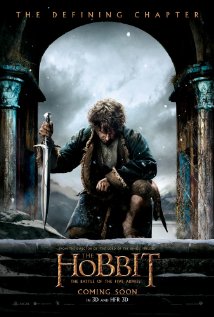 “The Hobbit: The Battle of the Five Armies” on IMDB
“The Hobbit: The Battle of the Five Armies” on IMDB
Fantasy/Adventure/Action, 144 Minutes, 2014
So, we’ve successfully slogged through “The Hobbit: An Unexpected Journey” [My Review] and “The Hobbit: The Desolation of Smaug” [My Review] and we’re finally now ready to wrap things up in the shortest entry in the series at only 144 minutes. So, for those keeping track at home, that’s just a shade under eight hours to adapt a book you can read in under 10.
It’s difficult to review this because almost everything I could say about it I’ve already said about the first two films. It’s ridiculously padded, something I doubt anybody would argue with. The additions were clearly designed to better align the story with “The Lord of the Rings” films but it’s questionable whether they succeeded; or even whether that was needed at all. The first two installments had difficulty balancing between goofy childishness and dread seriousness and so does this, although to a lesser extent.
This is, by far, the most serious of the trilogy. We’ve come to a point where our small company aren’t the only ones in jeopardy. The survival of hundreds of innocents also hang on their actions. This makes the many moments of slapstick humor even more inexplicable. In and of themselves, they do work, but they tend to change the tone too drastically to work well in the larger setting.
There’s also a definite bias towards maintaining audience expectations rather than accuracy. Where Thorin-of-the-book ended his story rather perfunctorily, Thorin-of-the-movie is given an extended personal trail and lengthy tearful redemption. Similarly, the wholly original love triangle between Orlando Bloom’s [IMDB] Legolas (who never appeared in the book), Evangeline Lilly’s [IMDB] Tauriel (who was created solely for the movies) and Aidan Turner’s [IMDB] Kili (who had no romantic diversions in the book) is given significant play. It’s pleasantly cinematic, but never stops feeling tacked on.
Using CGI for nearly all the fantasy creatures is only partially successful. On one hand, this allows for characters that would have been very difficult to pull off practically. On the other there is a disappointing sameness about them; a bland smoothness that allows them to be inserted into the scene more easily, but compromises the menace that they can generate. Even actors of this caliber can’t react to thin air as well as they can to actual (albeit rubber) monsters.
Again, as with the previous installments, these criticisms tend to pale when considered against the sad state of fantasy cinema. You simply won’t find many – or, indeed, any – movies in the genre being produced at this level. For all its flaws this is the still the absolute best option available for the sword and sorcery set.
It’s more successful as an extension of the cinematic “The Lord of the Rings” than as a realization of Tolkien’s story. Arguably it would have to be. The books have vastly different tones and style between them. It also makes sense to smooth over some of the more ridiculous events in the “The Hobbit”. The movie tends to fail most, however, when it favors its original notions more than the actual ones. It’s a good movie, but also a self-indulgent one.
